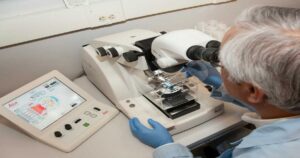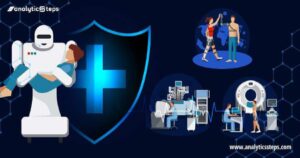A digital twin is a digital representation of a real-world entity or system. The implementation of a digital twin is a model that mirrors a unique physical object, process, organization, person or other abstraction. For healthcare providers, digital twins provide an abstraction of the healthcare ecosystem’s component characteristics and behaviors. These are used in combination with other real-time health system (RTHS) capabilities to provide real-time monitoring, process simulation for efficiency improvements, population health and long-term, cross-functional statistical analyses.
Digital twins have the potential to transform and accelerate decision making, reduce clinical risk, improve operational efficiencies and lower cost of care, resulting in better competitive advantage for HDOs. However, digital twins will only be as valuable as the quality of the data utilized to create them. The digital twin of a real-world entity is a method to create relevance for descriptive data about its modeled entity. How that digital twin is built and used can lead to better-informed care pathways and organizational decisions, but it can also lead clinicians and executives down a path of frustration if they get the source data wrong. The underlying systems that gather and process data are key to the success for digital twin creation. Get those systems right and digital twins can accelerate care delivery and operational efficiencies.
Twins in Healthcare Delivery
The fact is that HDOs have been using digital twins for years. Although rudimentary in function, digital representations of patients, workflow processes and hospital operations have already been applied by caregivers and administrators across the HDO. For example, a physician uses a digital medical record to develop a treatment plan for a patient. The information in the medical record (a rudimentary digital twin) along with the physician’s experience, training and education combine to provide a diagnostic or treatment plan. Any gaps in information must be compensated through additional data gathering, trial-and-error treatments, intuitive leaps informed through experience or simply guessing. The CIO’s task now is to remove as many of those gaps as possible using available technology to give the physician the greatest opportunity to return their patients to wellness in the most efficient possible manner.
Today, one way to close those gaps is to create the technology-based mechanisms to collect accurate data for the various decision contexts within the HDO. These contexts are numerous and include decisioning perspectives for every functional unit within the enterprise. The more accurate the data collected on a specific topic, the higher the value of the downstream digital twin to each decision maker (see Figure 1).

HDO CIOs and other leaders that base decisions on poor-quality digital twins increase organizational risk and potential patient care risk. Alternatively, high-quality digital twins will accelerate digital business and patient care effectiveness by providing decision makers the best information in the correct context, in the right moment and at the right place — hallmarks of the RTHS.
Benefits and Uses
Digital Twin Types in Healthcare Delivery
Current practices for digital twins take two basic forms: discrete digital twins and composite digital twins. Discrete digital twins are the type that most people think about when approaching the topic. These digital twins are one-dimensional, created from a single set or source of data. An MRI study of a lung, for example, is used to create a digital representation of a patient that can be used by trained analytics processes to detect the subtle image variations that indicate a cancerous tumor. The model of the patient’s lung is a discrete digital twin. There are numerous other examples of discrete digital twins across healthcare delivery, each example tied to data collection technologies for specific clinical diagnostic purposes. Some of these data sources include vitals monitors, imaging technologies for specific conditions, sensors for electroencephalography (EEG) and electrocardiogram (ECG). All these technologies deliver discrete data describing one (or very few) aspects of a patient’s condition.
Situational awareness is at the heart of HDO digital twins. They are the culmination of information gathered from IoT and other sources to create an informed, accurate digital model of the real-world healthcare organization. Situational awareness is the engine behind various “hospital of the future,” “digital hospital” and “smart patient room” initiatives. It is at the core of the RTHS.
Digital twins, when applied through the RTHS, positively impact these organizational areas (with associated technology examples — the technologies all use one or more types of digital twins to fulfill their capability):
Care delivery:
- Clinical communication and collaboration
- Next-generation nurse call
- Alarms and notifications
- Crisis/emergency management
- Patient engagement:
- Experiential wayfinding
- Integrated patient room
Risks
Digital Twin Usability
Digital twin risk is tied directly to usability. Digital twin usability is another way of looking at the issue created by poor data quality or low data point counts used to create the twins. Decision making is a process that is reliant on inputs from relevant information sources combined with education, experience, risk assessment, defined requirements, criteria and opportunities to reach a plausible conclusion. There is a boundary or threshold that must be reached for each of these inputs before a person or system can derive a decision. When digital twins are used for one or many of these sources, the ability to cross these decision thresholds to create reasonable and actionable conclusions is tied to the accuracy of the twins (see Figure 2).

For example, the amount of information about a patient room required to decide if the space is too hot or cold is low (due to a single temperature reading from a wall-mounted thermostat). In addition, the accuracy or quality of that data can be low (that is, a few degrees off) and still be effective for deciding to raise or lower the room temperature. To decide if the chiller on the roof of that patient wing needs to be replaced, the decision maker needs much more information. That data may represent all thermostat readings in the wing over a long period of time with some level of verification on temperature accuracy. The data may also include energy load information over the same period consumed by the associated chiller.
If viewed in terms of a digital twin, the complexity level and accuracy level of the source data must pass an accuracy threshold that allows users to form accurate decisions. There are multiple thresholds for each digital twin — based on twin quality — whether that twin is a patient, a revenue cycle workflow or hospital wing. These thresholds create a limit of decision impact; the lower the twin quality the less important the available decision for the real-world entity the twin represents.
Trusting Digital Twins for HDOs
The concept of a limit of detail required to make certain decisions raises certain questions. First, “how does a decision maker know they have enough detail in their digital twin to take action based on what the model is describing about its real-world counterpart?” The answer lies in measurement and monitoring of specific aspects of a digital twin, whether it be a discrete twin, composite twin or organization twin.
Users must understand the inputs required for decisions and where twins will provide one or more of the components of that input. They need to examine the required decision criteria in order to reach the appropriate level of expected outcome from the decision itself. These feed into the measurements that users will have to monitor for each twin. These criteria will be unique to each twin. Composite twins will have unique measurements that may be independent from the underlying discrete twin measurement.
The monitoring of these key twin characteristics must be as current as the target twin’s data flow or update process. Digital twins that are updated once can have a single measurement to gauge its appropriateness for decisioning. A twin that is updated every second based on event stream data must be measured continuously.
This trap is the same for all digital twins regardless of context. The difference is in the potential impact. A facilities decision that leads to cooler-than-desired temperatures in the hallways pales in comparison to a faulty clinical diagnosis that leads to unnecessary testing or negative patient outcomes.
All it takes is a single instance of a digital twin used beyond its means with negative results for trust to disappear — erasing the significant investments in time and effort it took to create the twin. That is why it is imperative that twins be considered a technology product that requires constant process improvement. From the IoT edge where data is collected to the data ingestion and analytics processes that consume and mold the data to the digital twin creation routines, all must be under continuous pressure for improvement.
Recommendations
Include a Concise Digital Twin Vision Within the HDO Digital Transformation Strategy
Digital twins are one of the foundational constructs supporting digital transformation efforts by HDO CIOs. They are digital representations of the real-world entities targeted by organizations that benefit from the advances and efficiencies technologies bring to healthcare delivery. Those technology advances and efficiencies will only be delivered successfully if the underlying data and associated digital twins have the appropriate level of precision to sustain the transformation initiatives.
To ensure this attention to digital twin worthiness, it is imperative that HDO CIOs include a digital twin vision as part of their organization’s digital transformation strategy. Binding the two within the strategy will reinforce the important role digital twins play in achieving the desired outcomes with all participating stakeholders.
- Building new capabilities — APIs, artificial intelligence (AI) and other new technologies enable the connections and automation that the platform provides.
- Leveraging existing systems — Legacy systems that an HDO already owns can be adapted and connected to form part of its digital platform.
- Applying the platform to the industry — Digital platforms must support specific use cases, and those use cases will reflect the needs of patients, employees and other consumers.
Create a Digital Twin Pilot Program
Like other advanced technology ideas, a digital twin program is best started as a simple project that can act as a starting point for maturity over time. Begin this by selecting a simple model of a patient, a department or other entity tied to a specific desired business or clinical outcome. The goal is to understand the challenges your organization will face when implementing digital twins.
The target for the digital twin should be discrete and easily managed. For example, a digital twin of a blood bank storage facility is a contained entity with a limited number of measurement points, such as temperature, humidity and door activity. The digital twin could be used to simulate the impact of door open time on temperature and humidity within the storage facility. The idea is to pick a project that allows your team to concentrate on data collection and twin creation processes rather than get tied up in specific details of the modeled object.
- Begin by analyzing the underlying source data required to compose the digital twin, with the understanding that the usability of the twins is directly correlated to its data’s quality. Understand the full data pathway from the IoT devices through to where that data is stored. Think through the data collection type needed for the twin, is discrete data or real-time data required? How much data is needed to form the twin accurately? How accurate is the data generated by the IoT devices?
- Create a simulation environment to exercise the digital twin through its paces against known operational variables. The twin’s value is tied to how the underlying data represents the response of the modeled entity against external input. Keep this simple to start with — concentrate on the IT mechanisms that create and execute the twin and the simulation environment.
- Monitor and measure the performance of the digital twin. Use the virtuous cycle to create a constant improvement process for the sample twin. Experience gained through this simple project will create many lessons learned and best practices to follow for complex digital twins that will follow.



